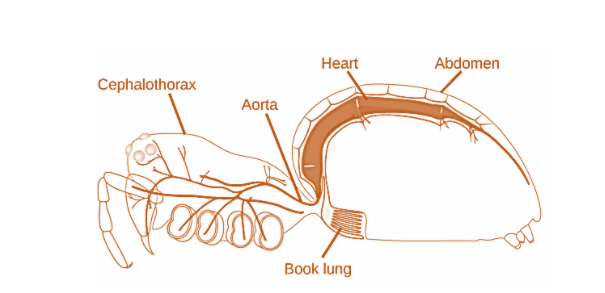
Book lungs occur in
A. Earthworms
B. Insects
C. Arachnids
D. Mammals
Answer
482.4k+ views
Hint: Book lungs, as the name suggests are respiratory organs in invertebrates. However, the structures are not equivalent to vertebrate lungs. These structures connect to the environment through small openings. Book lungs are present in a class of arthropods.
Complete answer:
Respiration is a basic necessity of all life forms. The vertebrates primarily respire through gills (in fishes) or lungs. The invertebrates have trachea or gills as their respiratory organs. Often, there are modifications observed in the invertebrate respiratory structures in accordance with the habitat of the animals.
Book lungs is a specialized respiratory organ. It is present in the animals of class Arachnida of phylum Arthropoda. The organ is present in air filled cavities in the abdominal region and connects to outside through minute pores. The flat leaf-like structure of the book lungs give them a closed book-like appearance, hence the name. Arachnids can have one pair to four pairs of book lungs.

Fig: Diagrammatic representation of the location of book lungs
Earthworms breathe through their skins. The gaseous exchange with the atmosphere takes place by diffusion. In order for the process of respiration to take place, the skin of these invertebrates should be kept moist.
Insects’ respiratory system comprises a dense network of tubules or the trachea. The respiratory organs of these organisms are minute pores on the body called spiracles. As the air enters the body through the spiracles, it is transferred to the tracheal system – which is responsible for delivering the oxygenated air to all parts of the insect body. Spiracles are located in the thorax and abdomen. They are guarded by flap-like structures that help to regulate the airflow through it.
Mammals are vertebrates, and therefore, lungs are the primary respiratory organs. There are a pair of lungs located in the chest cavity. The windpipe enters the lungs and forms extensive branches that terminate in alveoli. The alveoli remain in close contact with blood vessels. Respiration is a mechanical process of inhaling oxygen rich air while exhaling deoxygenated air. Gaseous exchange takes place through the process of diffusion in the alveoli and oxygen is transferred to the blood which carries it to the heart to be sent to different parts of the body.
Note: Book lungs are special respiratory organs present in Arachnids. They are composed of folded stacks of air pockets. These pockets remain in close contact with the haemolymph of the organisms. Book lungs are thought to have been evolved from book gills. Spiders and scorpions respire through book lungs.
Complete answer:
Respiration is a basic necessity of all life forms. The vertebrates primarily respire through gills (in fishes) or lungs. The invertebrates have trachea or gills as their respiratory organs. Often, there are modifications observed in the invertebrate respiratory structures in accordance with the habitat of the animals.
Book lungs is a specialized respiratory organ. It is present in the animals of class Arachnida of phylum Arthropoda. The organ is present in air filled cavities in the abdominal region and connects to outside through minute pores. The flat leaf-like structure of the book lungs give them a closed book-like appearance, hence the name. Arachnids can have one pair to four pairs of book lungs.

Fig: Diagrammatic representation of the location of book lungs
Earthworms breathe through their skins. The gaseous exchange with the atmosphere takes place by diffusion. In order for the process of respiration to take place, the skin of these invertebrates should be kept moist.
Insects’ respiratory system comprises a dense network of tubules or the trachea. The respiratory organs of these organisms are minute pores on the body called spiracles. As the air enters the body through the spiracles, it is transferred to the tracheal system – which is responsible for delivering the oxygenated air to all parts of the insect body. Spiracles are located in the thorax and abdomen. They are guarded by flap-like structures that help to regulate the airflow through it.
Mammals are vertebrates, and therefore, lungs are the primary respiratory organs. There are a pair of lungs located in the chest cavity. The windpipe enters the lungs and forms extensive branches that terminate in alveoli. The alveoli remain in close contact with blood vessels. Respiration is a mechanical process of inhaling oxygen rich air while exhaling deoxygenated air. Gaseous exchange takes place through the process of diffusion in the alveoli and oxygen is transferred to the blood which carries it to the heart to be sent to different parts of the body.
Note: Book lungs are special respiratory organs present in Arachnids. They are composed of folded stacks of air pockets. These pockets remain in close contact with the haemolymph of the organisms. Book lungs are thought to have been evolved from book gills. Spiders and scorpions respire through book lungs.
Recently Updated Pages
Master Class 12 Economics: Engaging Questions & Answers for Success

Master Class 12 Maths: Engaging Questions & Answers for Success

Master Class 12 Biology: Engaging Questions & Answers for Success

Master Class 12 Physics: Engaging Questions & Answers for Success

Master Class 12 Business Studies: Engaging Questions & Answers for Success

Master Class 12 English: Engaging Questions & Answers for Success

Trending doubts
Draw a labelled sketch of the human eye class 12 physics CBSE

Differentiate between homogeneous and heterogeneous class 12 chemistry CBSE

What are the major means of transport Explain each class 12 social science CBSE

Which of the following properties of a proton can change class 12 physics CBSE

What is a transformer Explain the principle construction class 12 physics CBSE

Why is the cell called the structural and functional class 12 biology CBSE




